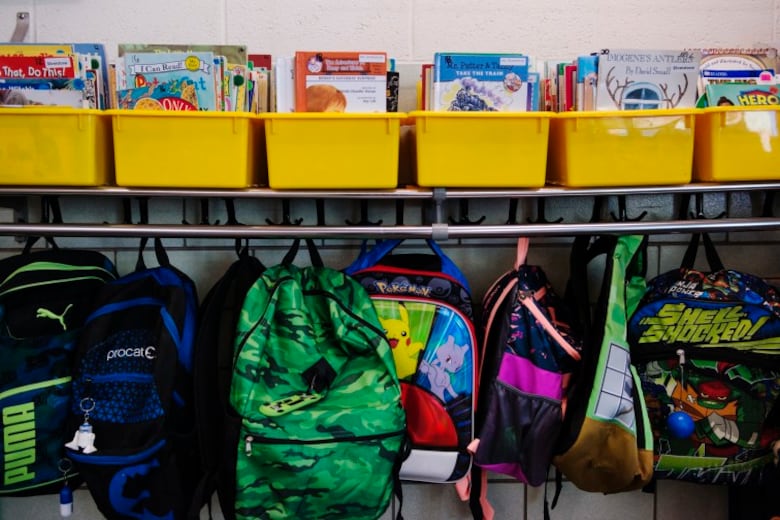From her kitchen table, Jennifer Meeks chats with three boys for a game of “word families,” where they take turns rhyming words with “at.”
“Tell me any letter and let’s see if it makes a word,” she coaxes a boy who’s been mostly quiet, sitting at a counter with his chin on his arm. “C,” he says, before spelling “cat.”
Meeks knows these boys well from her work tutoring homeless students as an education support coordinator for School on Wheels. But today, instead of meeting at their Indianapolis school, she is connecting by Zoom.
As coronavirus upends life for students around the country, Indiana educators are striving to ensure homeless families stay connected to resources for survival and support remote instruction. Families without stable housing are facing many of the same challenges as other parents: They need help finding food, paying bills, and getting their children the technology to participate in online schooling. But educators say that the crisis could have especially severe repercussions for homeless students, who are often behind academically and depend on schools for stability.
Without the connection of in-person school, students with unstable housing may fall through the cracks and miss out on essential support like help getting food, rental assistance, or tutoring.
Indianapolis had more evictions than any large U.S. city other than New York in 2016, according to data from The Eviction Lab at Princeton University. Despite the high eviction rate, homelessness has been on the decline in Indianapolis, but advocates expect there could be a national increase as the coronavirus pandemic wreaks havoc on the financial stability of low-wage workers.
Students who are homeless “are already behind to begin with. They already have struggles in life to begin with,” said Meeks, who typically works with these three boys at Urban Act Academy at School 14, a campus with some shelters in its neighborhood boundary where she spends three days per week. “Next year, we’re all going to have our work cut out for us.”
The eastside school educates about 325 students in kindergarten through eighth grade. Before school buildings closed, about 60 of its students were identified as homeless, according to Nigena Livingston, who overhauled the Indianapolis Public Schools campus as an innovation school in 2018.
With the help of School on Wheels, since its campus closed, School 14 has been able to touch base with all of the families who are designated as homeless, Livingston said. Students who are homeless are entitled to additional support from liaisons under the federal McKinney-Vento Homeless Assistance Act and certain services such as transportation to school. But schools only know if students qualify when parents or children tell staff about their living situation. Educators say that sometimes families move in with family or friends without telling schools.
People may be reluctant to say they are homeless because of the stigma or because they don’t know about the resources available to homeless students, Livingston said. At School 14, staff used to hold literacy or game nights so families would get information “in a way that they feel supported and not shamed,” she said. Now, “it’s been really, really hard to let families know what resources and support we have for them.”
Because school is now remote, families no longer need to ask for their children to get transportation from a new address, which can also make it harder to identify students who may qualify for support, said Tracy Beer, the McKinney-Vento liaison for Lawrence Township, an Indianapolis district of 16,000 students where about 380 qualify as homeless.
“A lot of families are thinking, ‘Oh, well, the schools are shut down. So no one can help me because no one’s there,’ ” Beer said. But while school buildings are closed, district staff are still working to support families, and she’s regularly reaching out to parents she was working with before the closures.
Gov. Eric Holcomb placed a moratorium on evictions while Indiana is in a state of emergency. But rent is still due, and families who have lost income and are unable to pay could face eviction when the moratorium lifts. If that happens, Beer said, “I honestly think we’re going to be bombarded.”
Because real-time data on homelessness is not available, it is hard to accurately assess whether the state is already seeing an increase, said Chelsea Haring-Cozzi, executive director of Coalition for Homeless Intervention and Prevention in Indianapolis. But providers are starting to hear from families who are homeless because of COVID-19.
“We’re really starting to prepare for households that hadn’t experienced homelessness before — who may be behind on rent now, behind on utilities because of loss of job or income,” Haring-Cozzi said.
If Indianapolis sees an increase in homelessness, schools will be charged with serving a growing number of high-need students who are potentially moving among schools.
Educators say they worry the most about the students who have never been identified as needing help or have disconnected from resources during the crisis.
“My biggest fear is for kids who fall off the radar right now,” said Kelly Coker, vice president of Programs for School on Wheels. “What about those families that the school hasn’t been able to contact and we haven’t been able to contact. What is happening there?”







